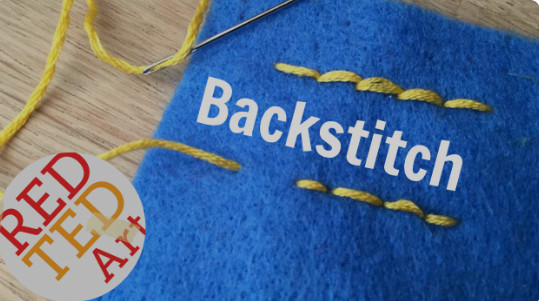Are You Eager to Learn Backstitch Basics? Dive into Embroidery with Our Beginner's Guide!
Embroidery, an age-old craft cherished for its intricate designs and therapeutic benefits, continues to captivate enthusiasts worldwide. For beginners eager to embark on their embroidery journey, mastering fundamental stitches like the backstitch is crucial. In this comprehensive guide, we'll delve into the art of backstitching, exploring its definition, techniques, and practical applications.
The backstitch is a foundational embroidery stitch characterized by its simplicity and versatility. Unlike other stitches that leave gaps between stitches, the backstitch creates a continuous line of stitching, resulting in a sturdy and visually appealing finish.
Charactristics
of backstitch: One of the distinguishing features of
the backstitch is its ability to create a continuous line of stitches,
resulting in a neat and professional-looking finish. Additionally, the
backstitch is highly adaptable and can be used in various embroidery projects,
from intricate patterns to simple designs.
The backstitch is renowned for its durability, making it suitable for decorative as well as functional embroidery. Its tight, solid lines make it ideal for outlining shapes, adding definition to motifs, or creating text in embroidery projects.
Embroidery hoop: An essential tool for embroidery, the hoop holds the fabric taut, allowing for smooth and even stitching. When selecting an embroidery hoop, choose one that is appropriate for the size of your project and comfortable to hold.
Embroidery hoops come in various sizes and materials, such as wood, plastic, or metal. Choose a hoop that feels sturdy and provides enough tension to keep your fabric flat while stitching.
Fabric: Choose a fabric that suits your project, whether it's cotton for delicate embroidery or linen for a rustic feel. Consider factors such as fabric weight, weave, and color when selecting your fabric, as these can impact the final appearance of your embroidery.
Needle: Select a needle appropriate for your fabric and thread, ensuring smooth stitching without damaging the fabric. Embroidery needles come in different sizes and types, such as sharp or blunt, depending on the fabric and thread thickness.
Thread: Use embroidery floss or thread in colors that complement your design, adding depth and dimension to your stitches. Embroidery thread is available in a wide range of colors and materials, such as cotton, silk, or metallic, allowing for endless creative possibilities in your embroidery projects.
Scissors: Sharp embroidery scissors are essential for cutting thread and trimming excess fabric with precision. Invest in a good pair of embroidery scissors with fine, pointed blades for accurate cutting without fraying the thread.
Marking tools: Marking tools such as water-soluble pens or chalk are handy for transferring designs onto fabric before stitching. Choose a marking tool that is suitable for your fabric and easily removable, ensuring that it won't leave any permanent marks on your embroidery.
Choosing a comfortable and well-lit area: Create a dedicated workspace with good lighting and ergonomic seating to ensure comfort and focus while embroidering. Natural daylight is ideal for embroidery, but if that's not possible, use artificial lighting that mimics natural light as closely as possible.
Setting up your embroidery hoop: Place the inner hoop under the fabric and the outer hoop over it, tightening the screw to secure the fabric in place. Adjust the tension of the hoop as needed to ensure that the fabric is taut but not stretched, allowing for smooth and even stitching.
Preparing your fabric: Wash and press your fabric to remove any wrinkles or creases, providing a smooth surface for stitching. Pre-washing your fabric will also remove any sizing or chemicals that may affect the appearance or texture of your embroidery.
Selecting the right thread: Choose a thread color that complements your fabric and design, ensuring visibility without overpowering the overall aesthetic. Consider factors such as fabric color, design complexity, and personal preference when selecting your thread color.
Cutting the thread to the appropriate length: Cut a length of thread approximately 18-24 inches long, depending on your comfort and the size of your project. Longer threads may lead to tangling, while shorter threads may require frequent re-threading.
Techniques for threading the needle: Use techniques such as licking the thread or using a needle threader to easily thread the needle, ensuring a smooth start to your stitching. Hold the thread between your thumb and forefinger, and gently guide it through the eye of the needle, taking care not to fray or split the thread.
Securing the thread on the fabric: Anchor the thread on the back of the fabric with a small knot or use a waste knot technique, ensuring it stays in place while stitching. Leave a small tail of thread on the back of the fabric to prevent the knot from slipping through the fabric.
Positioning the needle for the first stitch: Bring the needle up through the fabric at the starting point of your design, ready to begin stitching. Position the needle close to the fabric surface, taking care not to pull the thread too tightly or distort the fabric.
Making the initial stitch: Insert the needle back into the fabric a short distance ahead of the starting point, creating the first stitch of your backstitch line. Position the needle close to the previous stitch, taking care to maintain even spacing and tension throughout your stitching.
Technique for forming subsequent stitches: Continue stitching by bringing the needle up through the fabric a short distance ahead of the previous stitch, then inserting it back into the fabric at the end of the previous stitch. Position the needle close to the previous stitch, taking care to maintain even spacing and tension throughout your stitching.
Maintaining consistent stitch length: Keep your stitches uniform in length, ensuring a neat and tidy appearance to your backstitch line. Use a ruler or marking tool to guide your stitches in straight lines, maintaining precision and accuracy in your embroidery.
Tips for achieving straight lines: Use a ruler or marking tool to guide your stitches in straight lines, maintaining precision and accuracy in your embroidery. Experiment with different stitch lengths and tensions to create different effects and textures in your embroidery.
Method for navigating corners: When approaching a corner, pivot the needle at the corner point and continue stitching in the new direction, ensuring smooth transitions without gaps or overlaps. Position the needle close to the corner point, taking care to maintain even spacing and tension throughout your stitching.
Adjusting stitch length for curves: Shorten your stitch length slightly when stitching curves, allowing for greater flexibility and control in following the curvature of the design. Position the needle close to the previous stitch, taking care to maintain even spacing and tension throughout your stitching.
Practice exercises for mastering corners and curves: Practice stitching corners and curves on scrap fabric to hone your technique and build confidence in handling these challenging elements. Experiment with different stitching techniques and angles to find what works best for your embroidery design and stitching style.
Securing the final stitch: Complete your backstitch line and secure the final stitch by making a small knot on the back of the fabric or using a finishing knot technique. Position the needle close to the final stitch, taking care to maintain even spacing and tension throughout your stitching.
Techniques for tying off the thread: Tie off the thread securely to prevent unraveling, ensuring the longevity of your embroidery work. Position the needle close to the final stitch, taking care to maintain even spacing and tension throughout your stitching.
Trimming excess thread: Use sharp scissors to trim any excess thread close to the fabric, leaving a clean and polished finish to your embroidery. Position the scissors close to the fabric, taking care to avoid cutting the stitches or fabric.
Uneven stitch length: Pay attention to maintaining consistent stitch length throughout your embroidery, avoiding irregularities that can detract from the overall appearance of your work. Use a ruler or marking tool to guide your stitches in straight lines, maintaining precision and accuracy in your stitching.
Incorrect tension: Adjust the tension of your thread and fabric as needed, ensuring smooth and even stitching without puckering or pulling. Position the needle close to the fabric surface, taking care to maintain even spacing and tension throughout your stitching.
Skipping stitches: Take your time and stitch carefully, avoiding the temptation to skip stitches or rush through your embroidery, which can result in gaps or incomplete lines. Position the needle close to the fabric surface, taking care to maintain even spacing and tension throughout your stitching.
Simple designs to practice backstitching: Start with basic shapes or lettering to practice your backstitch technique, gradually increasing complexity as you gain confidence. Choose designs that are straightforward and easy to follow, allowing you to focus on perfecting your stitching technique.
Incorporating backstitch into larger projects: Experiment with incorporating backstitch into larger embroidery projects such as hoop art, samplers, or clothing embellishments, adding depth and detail to your creations. Use backstitch to outline shapes, add texture, or create focal points in your embroidery designs.
Resources for finding beginner-friendly patterns: Explore online tutorials, books, and embroidery kits designed for beginners, providing step-by-step guidance and inspiration for your embroidery journey. Look for patterns and designs that are labeled as beginner-friendly, with clear instructions and diagrams to help you get started.
Embroidery is a rewarding and versatile craft
that offers endless opportunities for creativity and self-expression. By
mastering the basics of backstitching, you'll lay the foundation for exploring
more advanced techniques and creating beautiful embroidery pieces that reflect your unique style and personality. So gather your
tools and materials, set up your workspace, and let your imagination take
flight as you embark on your embroidery adventure. Happy stitching!



